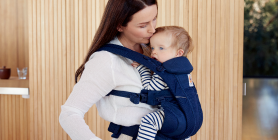What exactly is hip dysplasia? As the name suggests, it’s a deformation or a misalignment of the hip joint. The cup-like-formed acetabulum of the pelvis (also called the hip socket) and the round femoral head facilitate the movement of the legs. Both are covered with cartilage and a layer of fluid, which ensure a frictionless movement of the joint. The formation of the joint begins in the third month of pregnancy, yet it will not fully develop until the end of the pregnancy. By the time of birth, the newborn’s pelvis is almost entirely made out of cartilage. The ossification begins shortly after birth. The hip joint is reinforced by ligaments and the joint capsule. Muscles enable movement as well as supporting the hip joint. The German term for hip dysplasia was first used in 1936 to refer to a delayed growth of the ossification of the hip socket. The generic term of “infantile dislocation of the hip joint” was created by Dr. Ewald Fettweis. It is one of the most common skeleton structure disorders, and girls are 7 times more likely to be affected. Hip dysplasia is diagnosed in Germany with a frequency rate of 2-4 % and a luxation of the hip with 0.4 – 0.7%. What causes hip dysplasia? This malformation or dysplasia occurs due to a disruption or delay of the ossification of the pelvis, i.e., the transformation of cartilage into bone. The dislocation of the hip joint is not complete by birth and can happen in a breech birth or due to a malformation of the general structure of the hip area. A newly born child has a cartilage-like pelvis, whose rate of ossification differs with each individual infant. In this context, this ossification is called "shape-stabilization of the bone." There are multiple reasons why this shape-stabilization of the bone may not develop correctly: 1) Genetically determined delay of maturing 2) An exogenous physical injury due to: - The infant’s legs being forced upwards due to a breech position in the womb - Lying on the stomach (especially in the first 3 months) - Incorrect swaddling - Lying on the side (inconvenient positioning of the infant’s legs prevents the natural spread-squatting-position) - The use of a baby walker - Unnecessary, incorrect infant gymnastics - Taking the infant’s measurements by holding it by the feet, dangling it with its head down and its full weight on the hip joints. This can strain the baby’s hip socket, or possibly pull the femoral head out of the acetabulum. - Incorrect or rough treatment of the infant and/or an unfortunate combination of different factors The muscles themselves are another important aspect. According to Adolf Lorenz, the most appropriate position for the baby’s legs is the one the child naturally assumes in the uterus. In this position, the strong muscles used for sitting push the femoral head straight into the acetabulum, which leads to the cartilage diminishing, and being replaced with bone tissue. Orthopedists have discerned that the ideal position for an optimum growth of a child’s hip is an inflection at the hip joint of at least 90° (ideally 110°), while bending the knees and spreading them “at an angle of 35°-40°.” This is called the spread-squat-position, also referred to as the frog-position. Notice that when you pick up an infant, it naturally braces itself in this position, pulling its legs up into a spread-squatting-position, with the soles of the feet (almost) touching each other.
Prevention and Therapy
How is it treated? For over 100 years now, orthopedists, especially in German-speaking countries, have been dedicating their research to the infantile dislocation of the hip joint, or hip dysplasia. Before that, a dislocation was regarded incurable and thus, doctor’s even discouraged treatment. At the time there were no methods available to make a proper diagnosis. Towards the end of the nineteenth century, two pioneers made breakthrough discoveries, almost simultaneously. The Austrian orthopedist Adolf Lorenz published his work “About the mechanical treatment of innate dislocation of the hip joint” (1895), and Wilhelm Konrad Röntgen discovered X-ray technology that still bears his name in some languages including German: Röntgen. An exciting period in medicine commenced, full of new enlightenment and hope, but also of disappointment and harm. Many generations of medical scientists took part in its victories and failures, many of which we have lived to witness. The Lorenz Cast and other failed treatments In 1895, Adolf Lorenz introduced a method to treat hip luxation, the Lorenz-cast, which allowed an inflection and bracing of the legs at a 90-degree angle to the pelvis. Although signs of improvement were visible at first, the consequences were severe with long-term damage and complications. In dire need of a lasting solution, a multitude of methods – including special trousers, bandages and casts – and surgical procedures were attempted. Needless to say, these methods, although developed with the best intentions, were not successful. Dr. Graf’s medical breakthrough: the ultrasound pelvic examination As early as 1971, carefully documented preventative examinations of infants were introduced in Germany. Today, these obligatory examinations begin at birth and continue well into adolescence in order to spot any potential dangers and symptoms at their early stages. This allows immediate treatment to begin when indicated. An amazing medical breakthrough made it possible to diagnose a pelvic malformation at birth: the ultrasound examination of the pelvis, invented by Dr. Reinhard Graf in 1979. Graf’s method is based on measuring different angles focusing on the acetabulum. He analyzes and divides pelvic joints into nine different categories, which helps to determine the right therapy. The therapy can consist of everything from check-ups on a regular basis to interventions like spreading the legs, and repositioning, or fixating them. Before Graf’s screening, children were usually diagnosed only after nine months of age, which drastically limited the hope of successful treatment. Needless to say, the earlier a malformation is recognized, the more successful therapy one can hope for. How can you recognize it? What can parents do to preserve their children's healthy hip joints and recognize a potential complication? 1) Insist on an ultrasound right after birth in the case of any conspicuous medical history in the family. 2) Look at the obligatory ultrasound which is made during the 3rd precautionary examination, and get your child treated immediately if there is anything of concern. 3) Let the child sleep on its back during the night with its knees bent, securing this physiological position by placing a rolled up towel under the child’s knees. 4) Avoid the potential dangers listed above, such as taking the infant’s measurements by holding it at its feet and hanging it with its head down. 5) Carry the child in a physiologically sound baby carrier or a sling, as two-thirds of the world’s population does. A trained midwife or a baby wearing consultant will be glad to assist you in finding the healthiest and ideal position for your child. After all, children want to be carried!
References: Bund deutscher Hebammen. 2004. Das Neugeborene in der Hebammenpraxis. Hippokrates. Association of German Midwives. 2004. The Infant/New-born at the Midwife’s practice. Hippokrates. Dr. Fettweis, Ewald. 1992. Das kindliche Hüftluxationsleiden - Die Behandlung in Sitz-Hock-Stellung. Ecomed. Dr. Fettweis, Ewald. 1992. Suffering (from) an infantile hip luxation - Treatment in the Spread-Sqatting-Position. Ecomed. Dr. Fettweis, Ewald. 2004. Hüftdysplasie- Sinnvolle Hilfen für Babyhüften. Trias. Dr. Fettweis, Ewald. 2004. Hip dysplasia – How to treat infantile hips. Trias. Niethard, Pfeil. 2003 (4. Aufl.). Orthopädie. Thieme. Niethard, Pfeil. 2003 (4. edition.). Orthopedics. Thieme.
Emotional Benefits of Getting Outside
Spending time in nature with your baby can strengthen the bond between you. The simple act of holding your baby close, feeling their warmth, and sharing new experiences together can create strong emotional connections. It’s also a wonderful way to reduce stress and improve your mood. When my littles were extra fussy, I’d take a walk around the neighborhood. Even though I don't live in an area with trails and surrounded by nature, simply behind outside changed everything. A little vitamin D does wonders!
Cognitive Development
Nature is a sensory wonderland for babies. The different sights, sounds, and smells can stimulate your baby’s senses and promote cognitive development. Watching leaves rustle, hearing birds chirp, and feeling the texture of a tree bark can all contribute to their learning and development.
All About Baby Carriers for Nature Adventures
Choosing the Right Baby Carrier
When it comes to selecting the best baby carrier for summer adventures, there are several options to consider.
Types of Baby Carriers:
- Wraps: Perfect for newborns, providing a snug and secure fit.
- Slings: Ideal for quick and easy use, offering good ventilation.
- Soft Structured Carriers: Versatile and comfortable for both parent and baby, suitable for longer trips.
Factors to Consider:
- Baby’s Age and Weight: Ensure the carrier is appropriate for your baby’s size and weight. For example, Ergobaby’s Embrace Newborn Carrier is perfect for the fourth trimester where baby is small and you’re looking for an easy way to stay close. As they grow, you’ll want to upgrade to an all-position carrier that’s meant for growing babies.
- Parent’s Comfort and Ergonomics: Look for carriers with padded shoulder straps and lumbar support if you’re planning on longer outings.
- Ease of Use: Choose a carrier that is easy to put on and take off.
- Climate and Breathability: Opt for carriers made of breathable fabrics to keep you and your baby cool in hot weather.
Safety Tips:
- Proper Positioning: Ensure your baby is seated correctly, with their legs in an "M" position and their head should be close enough to kiss.
- Checking for Wear and Tear: Regularly inspect your carrier for any signs of damage.
- Ensuring Adequate Support: Make sure the carrier provides proper support for your baby’s head and neck.
Exploring Nature with a Baby Carrier
Ideal Spots for a Nature Walk with Baby
- Parks and Gardens: Great for leisurely walks and picnics.
- Nature Trails and Forests: Perfect for more adventurous outings.
- Beaches and Lakesides: Wonderful for enjoying the water and sand, with the right carrier.
Activity Ideas
- Hiking: Enjoy a scenic hike with a hiking baby carrier that offers support and storage.
- Bird Watching: Use your carrier to keep your baby close while you explore and observe wildlife.
- Picnics: A carrier can free up your hands, making it easier to carry picnic supplies.


Advantages of Using Strollers for Nature Adventures


While baby carriers are fantastic for mobility and closeness, depending on the adventure of choice you might want to be a stroller along too.
There are a LOT of baby stroller options on the market. So we understand how confusing it can be to choose the one that’s right for your family. Not only are there a variety of brands, but a variety of strollers that serve different purposes.
There are a few types of strollers on the market:
- Full-sized stroller: This is typically the stroller parents thing of buying for all its versatility.
- Lightweight or umbrella stroller:These compact strollers are perfect for on-the-go adventures.
- Jogging stroller: Designed for parents who want to combine fitness with outdoor adventures.
- Double stroller: Designed for parents with multiple kids, especially twins.
- Car seat carrier: These strollers connect to a specific car seat. We don't typically recommend these as they can be unsafe for baby and uncomfortable for parents who are pushing.
Learn more about the types of strollers and which one would be best for you.
Benefits of Bringing a Stroller
- Storage Space for Gear: Ample room for carrying all your essentials like a diaper bag, beach toys and more.
- Shade and Weather Protection: Built-in canopies to shield your baby from the sun when they are lounging.
- Options: If you have more than one kid, you can stroll with one and carry the other. Or, if you’re getting warm or your little one is getting fussy, you can switch up their position from stroller to carrier or vice versa.
Safety Tips for Strollers
- Ensure your stroller is in good working condition. Make sure buckles are still buckling and that there are no rips or holes that could compromise your baby’s safety.
- Use sunshades or bug nets to protect your little one’s skin.
- Securing the baby properly: always buckle up your baby for safety even if you think they are old enough to go without the buckle.
Combining Baby Carriers and Strollers
For the ultimate flexibility, consider using both a baby carrier and a stroller on your outings.
Combining both options allows you to adapt to different situations. Use the carrier for more rugged trails and switch to the stroller for smoother paths or when your baby needs a nap.
Transition Tips
- Smooth Transitions: Plan stops where you can easily switch from carrier to stroller.
- Pack Light: Only bring essentials to make transitions easier.
Tips for a Successful Adventure
Planning Ahead
- Route Planning: Choose baby-friendly trails and parks. Check local mom groups or outdoor groups and get recommendations for the best outings for kids.
- Check Weather Conditions: Avoid extreme heat or unpredictable weather. Even with our most breathable carriers, when it’s hot, it’s hot. And having two bodies against each other in the heat will be naturally hot and sticky already.
- Packing Checklist: Include diapers, snacks, water, sunscreen, and a first-aid kit. These all-position carriers have storage pockets where you can fit some of the items easily!
- Stay Hydrated and Nourished: Pack healthy snacks to keep energy levels up and bring plenty of water for both you and baby.


Summer adventures with your baby are a wonderful way to create lasting memories and enjoy the beauty of nature together. From baby carriers to strollers, Ergobaby products are designed to provide comfort and ease for both you and your little one. So, gear up, get outside, and explore the world with your baby by your side.
Ready to embark on your own summer adventures? Check out Ergobaby’s range of baby carriers and strollers to find the perfect match for your family’s needs. Visit our website today and start planning your next outdoor excursion!
























